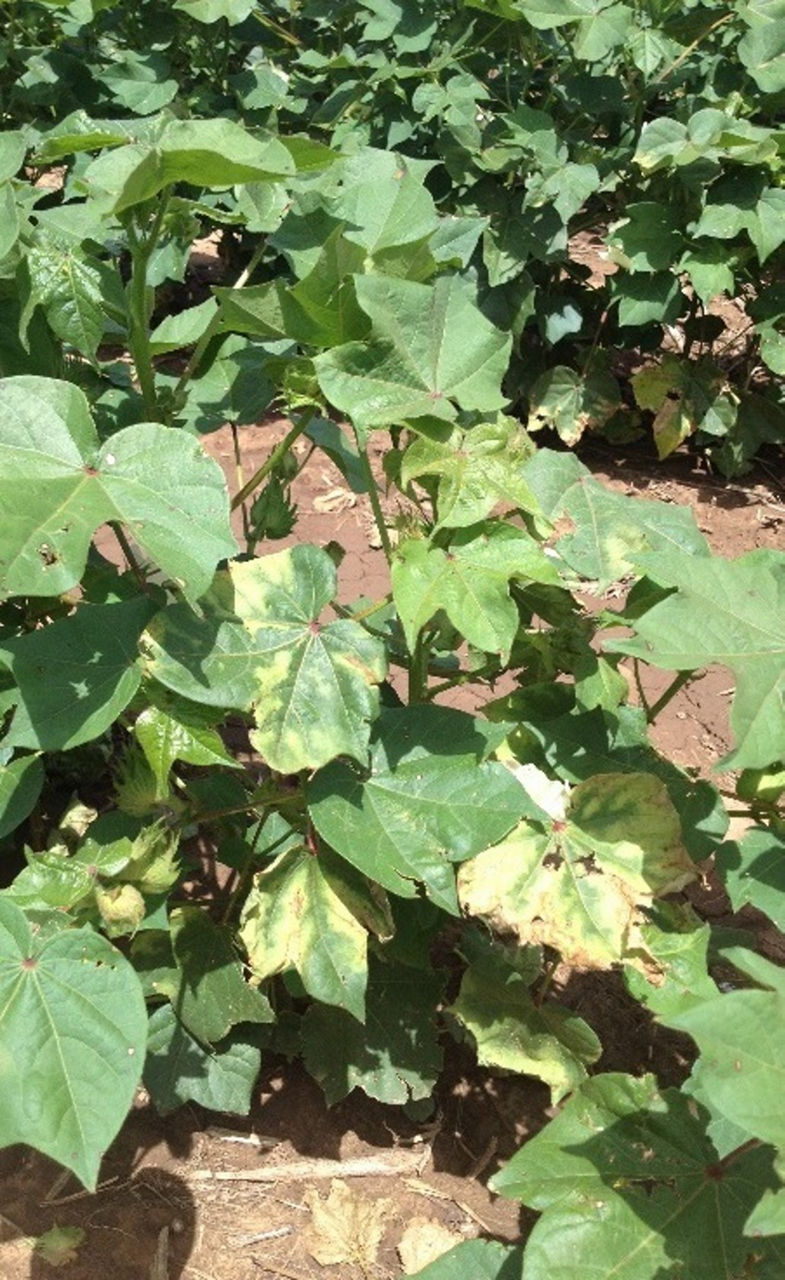7 MIN READ
Mid- to Late-season Stem, Root, and Boll Diseases in Cotton
August 16, 2019
Fusarium and Verticillium wilts are soil-borne pathogens that can be difficult to manage. Symptomology of the two diseases are similar, making diagnosis difficult. Stem discoloration is typically more evenly distributed with Verticillium wilt. For confirmation of a wilt disease, the bottom stems of cotton plants may be sent to a diagnostic lab. Refer to your local university extension service for sampling procedures.
Proper fertility management, crop rotation to corn or soybean, use of nematicides, and cotton variety selection can help reduce yield losses from wilt diseases. Cotton varieties with improved levels of resistance to Fusarium and Verticillium wilt and nematode resistance are available to help reduce disease incidence (Table 1).
Boll rots can be caused by several different bacteria and fungi. Rank growth coupled with insect damage can provide an opportunity for infection. Preventing boll rot requires a combination of several management practices.
Table 1. Fusarium and Verticillium ratings for Deltapine® cotton varieties.

Fusarium Wilt
Symptoms
Fusarium wilt (Fusarium oxysporum f. sp. vasinfectum) is a fungal disease that can be identified by wilted or dying plants possibly with interveinal chlorosis. Stems can be carefully and shallowly sliced open to reveal brown vascular tissue indicating damage to the vascular system (Figure 1). This results in poor movement of water and nutrients through the plant and causes the plant to wilt. Fusarium wilt is more likely to be present in fields with root-knot nematodes. Symptomatic plants can have substantial root galling.1
Diagnostic Notes
Fusarium wilt can be observed across cotton growing areas but tends to occur in specific pockets. This is true in the field as well. Infected plants will be found in clusters instead of throughout the field.1
A new race of Fusarium wilt, race 4 or FOV4, was confirmed in Texas in 2017. This race was previously confined to California.

Unlike other races of Fusarium wilt, presence of FOV4 in a field is independent of nematodes. FOV4 attacks early in the season (many times on cotton as young as 3 or 4 nodes). Symptom on-set is rapid, resulting in root rotting, vascular discoloration, and significant stand loss.2
Potential Yield Loss and Control
Plants severely infected with Fusarium wilt coupled with damage from root-knot nematodes can lead to plant death and substantial decreases in yield potential. It is recommended to plant root-knot nematode resistant cotton varieties and control nematode populations in the field.1 To help limit the spread of Fusarium, especially in the case of FOV4, it is important to clean equipment prior to moving to another field and limit tillage in infected fields.2
Verticillium Wilt
Symptoms
A plant infected with Verticillium wilt (Verticillium dahliae) may appear wilted and stunted next to a healthy plant. As the disease progresses, irregular leaf mottling follows. Some areas of the leaf may turn brown and die, while others can remain green (Figure 2). Infected plants can be found next to a heathy plant and will have fewer fruiting positions. Plant stems may be carefully sliced to reveal brown or black staining in the vascular tissue.3
Diagnostic Notes
Verticillium wilt has been observed across cotton growing areas. This disease spreads quickly in cool, moist, and medium to fine textured soils.3 Fields with a history of Verticillium and heavy inoculum levels can have problems in seasons with above average rainfall or irrigation followed by rainfall and a heavy boll load.
Potential Yield Loss and Control
Infected fields can have substantial yield loss and lower fiber quality. In fields with a history of Verticillium wilt, it is recommended to plant varieties that show resistance to this disease. Infected crop residue should be destroyed by chopping stalks and incorporating plant material into the soil for faster decomposition. Winter weeds should be controlled to limit plant hosts for the disease and crop rotation can be used to help reduce inoculum in the field.3

Cotton Root Rot
Symptoms
Plants infected with cotton root rot (Phymatotrichum omnivorum) will be permanently wilted by the third day of expressing wilt and can rapidly die. Wilted plants can be found directly next to healthy, non-wilted plants. Leaves remain attached and plants can be easily pulled out of the soil due to rotten roots. Roots can have white to brown fungal growth and white, cottony growth can be observed just below the soil surface.4
Diagnostic Notes
Cotton root rot is primarily found in Texas and Arizona in areas where the annual minimum mean temperature is 60 ˚F. The disease tends to be limited to alkaline soils, and favors calcareous, montmorillonitic clays. Within an affected field, noticeable dead areas can be seen. Affected areas tend to be random throughout the field. Disease incidence is higher in wet conditions.4
Potential Yield Loss and Control
A cotton crop infected with cotton root rot can have lower fiber quality and lower harvest efficiency due to rotten plants clogging the harvester. Cultural control has been largely unsuccessful for controlling cotton root rot. Applying the fungicide flutriafol to the soil at planting to areas known to be problematic can be an effective and economical way to control cotton root rot.4
Sources:
1 Whitaker, J., Culpepper, S., Freeman, M., Harris, G., Kemerait, B., Perry, C., Porter, W., Roberts, P., Liu, Y., and Smith, A. 2018. 2019 UGA Cotton Production Guide. The University of Georgia.
2 Isakeit, T. and Morgan, G. 2018. Limiting the spread of fusarium wilt race 4, a new disease of cotton in Texas. Texas AgriLife Extension. https://agrilife.org/texasrowcrops/2018/09/11/limiting-the-spread-of-fusarium-wilt-race-4-a-new-disease-of-cotton-in-texas/.
3 Raper, T., Meyer, B., Lawrence, K., Sandlin, T., Cutts, T., Silvey, N., Burmester, C., Dill, T., Shelby, P., and Kelly, H. 2017. Verticillium wilt in Tennessee valley cotton. W403. http://news.utcrops.com/wp-content/uploads/2017/03/W403.pdf.
4 Isakeit, T. 2016. Cotton root rot (Phymatotrichopsis root rot) and its management. Texas AgriLife Extension. PLPA-FC010-2016. https://www.cottoninc.com/wp-content/uploads/2018/01/Cotton-root-rot-phymatotrichopsis-management.pdf.
5 Cutts, T. 2016. Cotton boll rot: potential causes and management considerations. Alabama Cooperative Extension System. https://agfax.com/2016/10/28/alabama-cotton-boll-rot-potential-causes-management-considerations/.
(Sources Verified 7/12/19)
5005_S2
